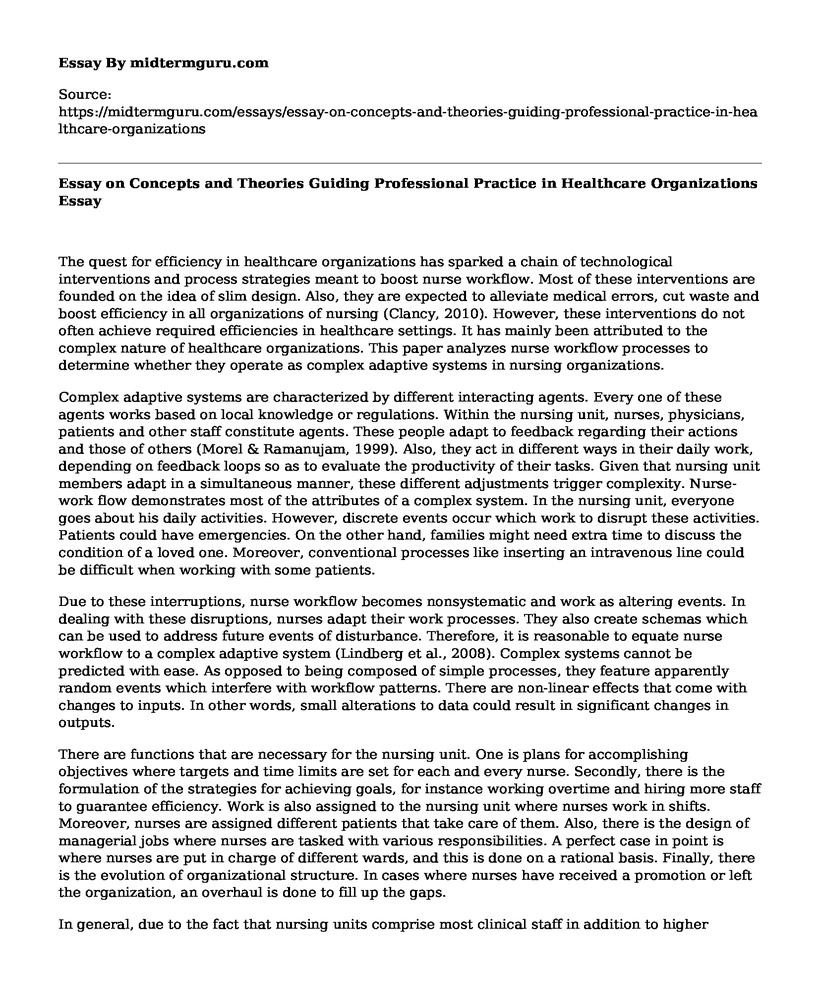The quest for efficiency in healthcare organizations has sparked a chain of technological interventions and process strategies meant to boost nurse workflow. Most of these interventions are founded on the idea of slim design. Also, they are expected to alleviate medical errors, cut waste and boost efficiency in all organizations of nursing (Clancy, 2010). However, these interventions do not often achieve required efficiencies in healthcare settings. It has mainly been attributed to the complex nature of healthcare organizations. This paper analyzes nurse workflow processes to determine whether they operate as complex adaptive systems in nursing organizations.
Complex adaptive systems are characterized by different interacting agents. Every one of these agents works based on local knowledge or regulations. Within the nursing unit, nurses, physicians, patients and other staff constitute agents. These people adapt to feedback regarding their actions and those of others (Morel & Ramanujam, 1999). Also, they act in different ways in their daily work, depending on feedback loops so as to evaluate the productivity of their tasks. Given that nursing unit members adapt in a simultaneous manner, these different adjustments trigger complexity. Nurse-work flow demonstrates most of the attributes of a complex system. In the nursing unit, everyone goes about his daily activities. However, discrete events occur which work to disrupt these activities. Patients could have emergencies. On the other hand, families might need extra time to discuss the condition of a loved one. Moreover, conventional processes like inserting an intravenous line could be difficult when working with some patients.
Due to these interruptions, nurse workflow becomes nonsystematic and work as altering events. In dealing with these disruptions, nurses adapt their work processes. They also create schemas which can be used to address future events of disturbance. Therefore, it is reasonable to equate nurse workflow to a complex adaptive system (Lindberg et al., 2008). Complex systems cannot be predicted with ease. As opposed to being composed of simple processes, they feature apparently random events which interfere with workflow patterns. There are non-linear effects that come with changes to inputs. In other words, small alterations to data could result in significant changes in outputs.
There are functions that are necessary for the nursing unit. One is plans for accomplishing objectives where targets and time limits are set for each and every nurse. Secondly, there is the formulation of the strategies for achieving goals, for instance working overtime and hiring more staff to guarantee efficiency. Work is also assigned to the nursing unit where nurses work in shifts. Moreover, nurses are assigned different patients that take care of them. Also, there is the design of managerial jobs where nurses are tasked with various responsibilities. A perfect case in point is where nurses are put in charge of different wards, and this is done on a rational basis. Finally, there is the evolution of organizational structure. In cases where nurses have received a promotion or left the organization, an overhaul is done to fill up the gaps.
In general, due to the fact that nursing units comprise most clinical staff in addition to higher expenses, showing that nurse workflows operate as complex adaptive systems will be crucial in understanding how to make successful interventions in this setting.
References
Clancy, T. (2010). Technology and complexity: Trouble brewing? J Nurs Adm. 2010; 40(6):247-
249
Lindberg, C., Nash, S., & Lindberg, C. 2008). On the edge: Nursing in the age of complexity.
Bordentown, NJ: Plexus Press; 2008
Morel, B & Ramanujam, R. (1999). Through the looking glass of complexity: The dynamics of
organizations as adapting and evolving systems. Org Sci. 1999; 10(3):278-293
Cite this page
Essay on Concepts and Theories Guiding Professional Practice in Healthcare Organizations. (2021, Jun 01). Retrieved from https://midtermguru.com/essays/essay-on-concepts-and-theories-guiding-professional-practice-in-healthcare-organizations
If you are the original author of this essay and no longer wish to have it published on the midtermguru.com website, please click below to request its removal:
- The Health Strategy is the Community Action Program for Public Health
- Nutritional Planning for Preparing for Fitness - Paper Example
- Health History and Examination - Paper Example
- What Are the Consequences of Obesity? - Essay Sample
- Nutrition Science and Its Benefits: Beyond Weight Management - Essay Sample
- Drug Abuse & Overdose Death Rates Rise in US - Essay Sample
- Conducting an RCA: Understanding Challenges & Taking Action - Research Paper







